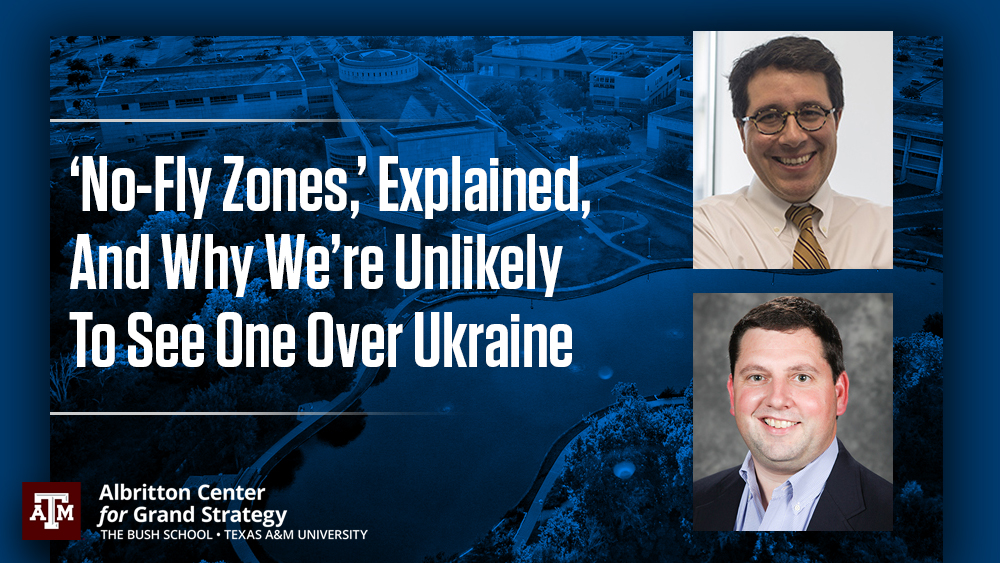
In the face of Russia’s ongoing invasion of Ukraine, many within Ukraine and around the world have called for the U.S. and its NATO allies to turn Ukrainian airspace into a “no-fly zone.”
To shed light on what this action would mean and explain why NATO leaders have been resistant to these calls, Texas A&M Today spoke with associate professors John Schuessler and Jasen Castillo of the Bush School of Government and Public Service. Schuessler and Castillo are members of the Department of International Affairs and co-directors of the Albritton Center for Grand Strategy.
Why have Ukrainian President Volodymyr Zelenskyy and others called for the U.S./NATO to impose a no-fly zone over Ukraine?
Schuessler: Ukraine is heavily outgunned by Russia. While Russia is primarily relying on artillery to shell Ukrainian cities, it holds an advantage in the air as well. So, Ukraine would benefit militarily from a no-fly zone that kept Russian planes from bombing Ukrainian cities. More importantly, a no-fly zone would pull the U.S. and NATO into the war between Ukraine and Russia, increasing Ukraine’s chances of averting defeat.
Castillo: The interesting thing about a no-fly zone is that the Russian air force has largely not been a big factor in the war. In fact, many of us are puzzled about why they haven’t achieved air supremacy. They simply haven’t been flying many “sorties,” or missions.
What is a no-fly zone, and what would the imposition of one actually mean?
Schuessler: A no-fly zone would start with an announcement by NATO that Russian planes are not permitted to fly over Ukraine. The trick would be in enforcing it. To enforce a no-fly zone, NATO would have to achieve air superiority over Ukraine, which would involve suppressing Russia’s extensive air defenses in the area and then shooting down any Russian aircraft that chose to defy the no-fly zone. Perhaps the most common misconception about a no-fly zone is that it is a measure short of war, when in fact it would bring NATO into direct combat with Russian forces.
Castillo: For NATO to shut down the Russian air defense and gain air supremacy, the alliance (read: the U.S.) would need to generate several sorties with aircraft not already in Europe, and it would take several days if not weeks. Russia would also use its array of ballistic and land-attack cruise missiles to strike NATO airfields, which would result in civilian casualties. In other words, this would not be fighting Saddam Hussein. NATO pilots will die and NATO likely achieves its objectives through attrition. And the reward for achieving this no-fly zone is that Russia might then use nuclear weapons to prevent it.
How likely is it that the U.S. and its allies would actually move to create a no-fly zone over Ukraine?
Schuessler: Exactly because a no-fly zone could easily lead to war between NATO and Russia, it is quite unlikely that the alliance will impose one. Instead, NATO will continue to look for indirect ways to aid the Ukrainian military while punishing Russia diplomatically and economically.
What has the U.S. been doing to support Ukrainians and oppose the Russian invasion while still avoiding direct military confrontation with Russia?
Schuessler: The U.S. and its European allies have been supplying Ukraine with weapons, such as anti-tank missiles. They have also imposed punishing sanctions on the Russian economy, especially the financial sector. The goal has been to increase the cost that Russia is paying for the invasion of Ukraine. It is an open question whether such measures will be sufficient to save Ukraine. In the event Ukraine’s government falls and is forced into exile, the U.S. and its allies will have to decide how extensively to support any insurgency against Russia’s occupation. They will also have to decide whether even more drastic sanctions – such as an embargo of Russian oil and gas exports – are in order. As importantly, the U.S. and its allies need to consider what the diplomatic endgame in Ukraine will look like, so that the war does not drag on endlessly or escalate dangerously.
What else should the average person know about the situation in Ukraine, especially where calls for a no-fly zone are concerned?
Schuessler: Outrage at Russian behavior is perfectly understandable. As is a desire to help the people of Ukraine. However, direct combat with a nuclear-armed Russia is exceedingly dangerous. Indeed, the Cold War stayed cold exactly because the U.S. and the Soviet Union avoided such run-ins. Whatever the surface appeal of a no-fly zone, it is an act of war and should be ruled out for that reason.
Castillo: Rightly or wrongly, Russia sees this as their Cuban Missile Crisis. Keep in mind that crisis did not end in war because both sides not only threatened one another but also provided off ramps in the form of concessions. The longer this war goes forward, the more dangerous it is for everyone. For this reason, all sides need to figure out what they are willing to concede in a bargain. This war will not end because sanctions cause the Russian people to overthrow Putin.
By Luke Henkhaus, Texas A&M University Division of Marketing & Communications
Note: This story originally appeared in TAMU Today on March 15, 2022

